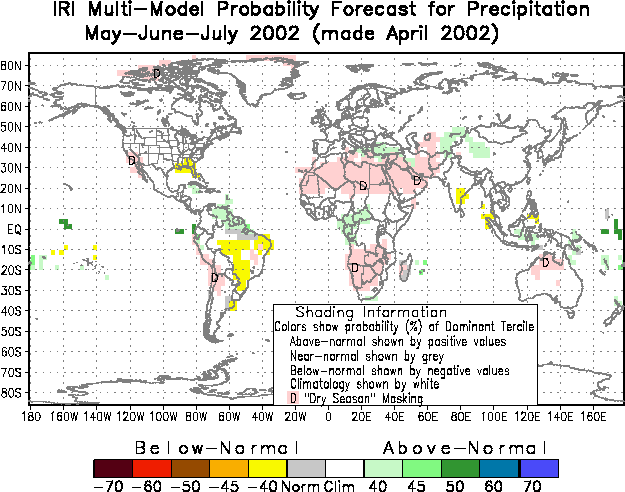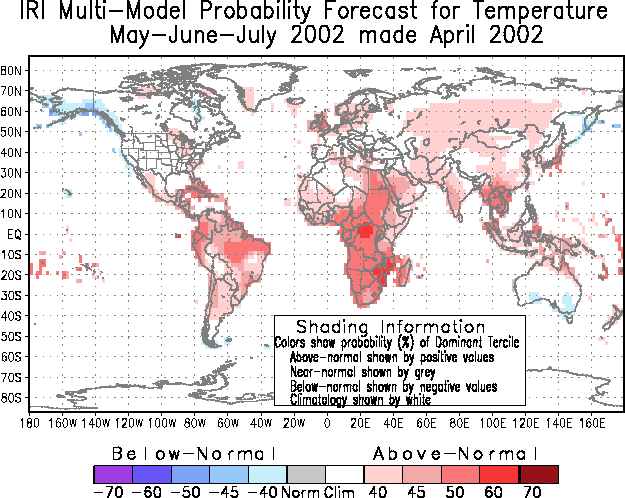|
IRI Climate Digest
April 2002
May-June-July Seasonal Forecast
Date and Period of Forecast
In April 2002, the IRI prepared a Climate Outlook for May-October 2002. Here we provide a subset of the April IRI Forecast. The forecasts are updated monthly and can be found in their entirety at http://iri.columbia.edu/climate/forecast/net_asmt/.
Uncertainties
This Climate Outlook is dependent on the quality of the sea surface temperature (SST) predictions. For the tropical Pacific, these predictions can be expected to provide useful information, but there is some uncertainty concerning the detailed evolution of SSTs. Spread in global SST predictions is a source of uncertainty in the Outlook provided here. The procedures, models, and data used to derive this Climate Outlook may be somewhat different from those used by National Meteorological Services in particular regions and may differ from the official forecasts issued in those areas.
Regional Influences
The current status of seasonal-to-interannual climate forecasting allows prediction of spatial and temporal averages, and does not fully account for all factors that influence regional and national climate variability. This Outlook is relevant only to seasonal time scales and relatively large areas; local variations should be expected. For further information concerning this and other guidance products, users are strongly advised to contact their National Meteorological Services.
Precipitation Outlook
The Outlook for other regions of the globe for the seasons May-June-July and August-September-October can be found at Net Assessment forecasts.
Maps show expected precipitation probabilities in tercile classes. The maps indicate probabilities that seasonal precipitation will fall into the wettest third of the years (top number), the middle third of years (middle number) or the driest third of the years (bottom). An outlook of climatology "C" (no color) indicates equal probabilities in each class; i.e., there is no basis for favoring the forecast of any particular category. Boundaries between sub-regions should be considered transition zones, and their location considered to be only qualitatively correct. Color shading indicates which tercile class has the greatest probability of occurrence with darker shading indicating greater likelihood as shown by the legend to the right of the plots.
May-June-July 2002 Global Precipitation Probabilities

Temperature Outlook
This forecast consists of expected probabilities of temperature in tercile classes. The terciles refer to the seasonal temperature falling into the warmest third of the years (top tercile), the middle third of years (middle tercile) or the coldest third of the years (bottom tercile). Boundaries between sub-regions should be considered transition zones, and their location considered to be only qualitatively correct. Color shading indicates which tercile class has the greatest probability of occurrence with darker shading indicating greater likelihood as shown by the legend on the bottom of the plots. Note:
The IRI is in the process of implementing new graphics for its forecast products. Currently, global maps only indicate (by shading) the tercile class with the greatest probability of occurrence.
Please consult the regional maps at Net Assessment forecasts for the probabilities of each tercile class.

Ocean Conditions
Of relevance in the preparation of this outlook is the prediction of somewhat above normal conditions in the eastern equatorial Pacific for the next 6 to 9 months, with more strongly above normal sea surface temperature (SST) toward the end of the period. Currently the SST across much of the eastern and central equatorial are slightly above their long-term average(SSTs), particularly in the eastern quarter of the tropical Pacific basin and also near the dateline in the central Pacific. During the first season of the forecast May-July 2002, the area of above average SST is expected to spread more evenly across the eastern and central tropical Pacific, averaging near or just above one-half degree C above normal. During the second, third and fourth seasons June-August 2002, July-September 2002, August-Octover 2002, SSTs are expected to become somewhat more strongly above average. These SST predictions imply the development of a weak El Nino (SSTs between 0.5 and 1 degree C above normal) during the first two forecast periods, continuing into the latter half of the year. Note that this prediction for a weak El Nino is that given by one particular ENSO prediction model. It is described here because it served as the boundary forcing for the following climate prediction, which is primarily based on dynamical global climate models. This should not be confused with the IRI's ENSO Statement, which while indicating a significant potential for an El Nino to develop also highlights the uncertainty that is still present in the prediction at this time. In the other tropical oceans, warmer than average SSTs continue to dominate much of the Indian Ocean. These are expected to decrease slowly through the forecast period, becoming slightly below normal near the coast of southern Asia and in parts of western Indonesia in the later forecast periods. The area of above-average temperature in the tropical north Atlantic Ocean has rapidly weakened, and is expected to play a smaller role than that implied in the SST forecasts. The climate forecasts have therefore been adjusted to reflect this difference.
Methods
The following procedures and information were used to prepare this Climate
Outlook:
- Coupled ocean-atmosphere model predictions of tropical Pacific SST
-- particularly heavy weighting has been given to the NOAA /NCEP,
Climate Modeling Branch coupled model
- Statistical forecasts of Indian Ocean and Atlantic Ocean sea surface
temperature
- The response of Atmospheric global circulation model (GCM) predictions
to the present and predicted SST patterns
- Statistical analyses
- Appropriate Regional Climate Outlook Forum consensus guidance.
|
Additional sources of information include ACMAD, COLA, CPTEC, CPC/NOAA,
CMC, Department of Natural Resources (Queensland, Australia), NIWA, ECMWF,
Indian Meteorological Department, PAGASA, Bureau of Meteorology, and the
South African Weather Bureau.
|
Contents |
Special |
Impacts |
Climate |
Forecast
|

